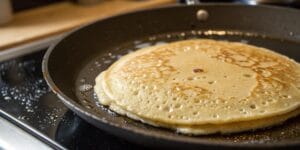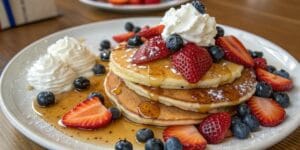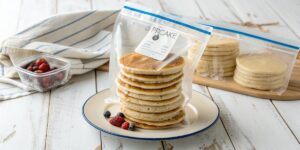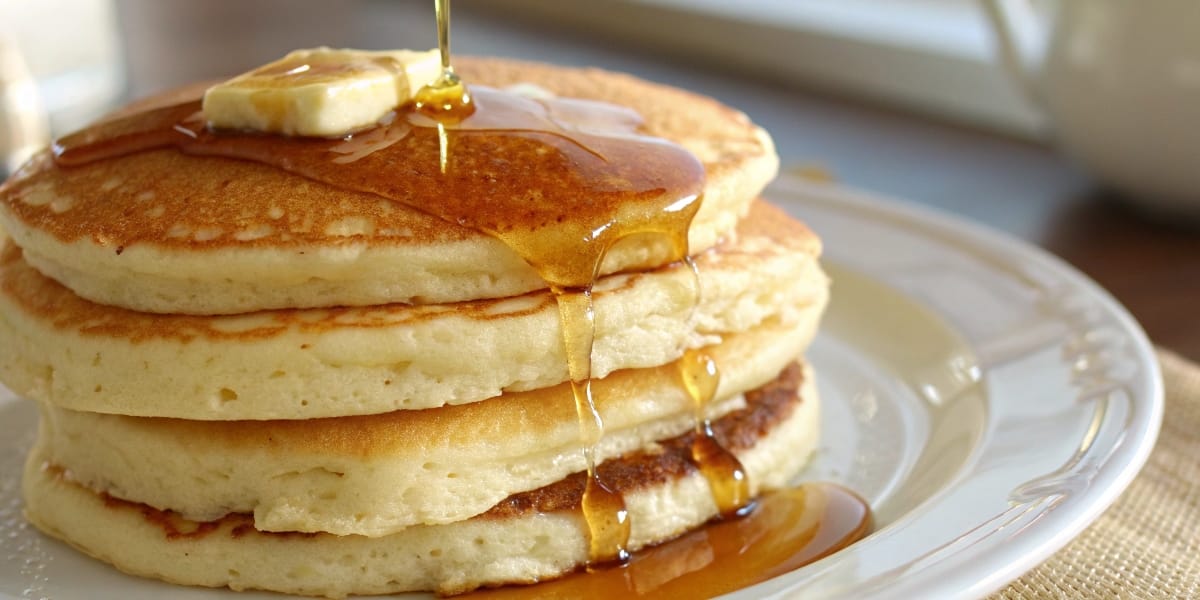Pancakes are a beloved breakfast staple, offering a delicious and versatile meal that can be customized to suit any taste. Whether you like them light and fluffy or thin and crispy, mastering an easy pancake recipe is a must for any home cook. In this guide, you’ll learn the secrets to making perfect pancakes every time, from choosing the right ingredients to flipping like a pro. We’ll also cover common mistakes, the ideal pancake formula, and tasty variations to keep breakfast exciting.
The Secret to Perfect, Fluffy Pancakes
Making great pancakes isn’t just about mixing ingredients and cooking them on a pan. The secret to perfect pancakes lies in:
- Using fresh, high-quality ingredients
- Properly mixing the batter without overworking it
- Cooking at the right temperature to ensure even browning
- Flipping at the perfect moment for the best texture
By following these essential tips, you can create a stack of pancakes that are soft, fluffy, and downright irresistible.
Essential Ingredients for Pancakes
Getting the ingredients right is the first step to making light, fluffy pancakes. While the recipe may seem simple, the quality and type of ingredients you use can significantly impact the texture and flavor.
Core Ingredients You Need
A classic pancake recipe consists of:
| Ingredient | Purpose |
|---|---|
| All-purpose flour | Provides structure and texture |
| Baking powder | Helps the pancakes rise and become fluffy |
| Sugar | Adds slight sweetness and helps with browning |
| Salt | Enhances flavor and balances sweetness |
| Eggs | Binds ingredients together and adds richness |
| Milk or buttermilk | Creates moisture and soft texture |
| Melted butter or oil | Adds flavor and prevents sticking |
These basic ingredients come together to form the perfect pancake batter, but some variations can enhance or alter the recipe depending on your preference.
Best Flour for Soft Pancakes – Soft or Hard?
One of the most common questions about pancakes is which type of flour to use:
- Soft flour (low-protein, like cake flour or pastry flour): Produces extra soft, tender pancakes.
- Hard flour (high-protein, like bread flour): Results in chewy, dense pancakes.
The best choice? All-purpose flour is the perfect middle ground, offering both softness and structure. If you prefer even fluffier pancakes, try replacing a portion of all-purpose flour with cake flour.
Can You Use Regular Milk Instead of Buttermilk?
Yes, you can! While buttermilk adds a slight tang and extra fluffiness due to its acidity reacting with baking soda, regular milk works just fine. If you don’t have buttermilk, try these substitutes:
- DIY Buttermilk: Add 1 tablespoon of lemon juice or vinegar to 1 cup of milk and let it sit for 5 minutes.
- Yogurt or Sour Cream: Mix equal parts yogurt or sour cream with water or milk for a similar tangy effect.
Using buttermilk or one of these substitutes helps create lighter, more tender pancakes, but if you only have regular milk, your pancakes will still turn out delicious!
Step-by-Step Guide to Making Easy Pancakes

Now that you have your ingredients ready, it’s time to make the perfect batch of pancakes. Follow these simple steps to achieve light, fluffy pancakes every time.
Mixing the Batter – Achieving the Right Consistency
- Combine the dry ingredients
- In a large mixing bowl, whisk together 1 ½ cups all-purpose flour, 3 ½ teaspoons baking powder, 1 tablespoon sugar, and ½ teaspoon salt. This ensures an even distribution of leavening agents, which helps your pancakes rise properly.
- Prepare the wet ingredients
- In another bowl, whisk together 1 ¼ cups milk, 1 egg, and 3 tablespoons melted butter until smooth. If using buttermilk, replace the milk accordingly.
- Mix dry and wet ingredients together
- Slowly pour the wet mixture into the dry ingredients while gently stirring. Avoid overmixing—lumps are okay! Overmixing leads to dense pancakes because it overdevelops the gluten in the flour.
- Let the batter rest
- Allow the batter to sit for 5-10 minutes before cooking. This helps the flour absorb moisture, resulting in softer pancakes.
How to Cook Pancakes Evenly on the Stove
- Preheat your pan or griddle
- Heat a non-stick skillet or griddle over medium heat. A good temperature is 350°F (175°C). If the pan is too hot, the pancakes will burn on the outside while remaining raw inside.
- Grease the pan lightly
- Use butter or a small amount of oil to prevent sticking. Wipe off excess with a paper towel so you don’t get greasy pancakes.
- Pour the batter
- Use a ¼ cup measuring cup to scoop and pour the batter onto the pan. This ensures evenly sized pancakes.
- Wait for bubbles to form
- Let the pancakes cook until bubbles appear on the surface and the edges look set (about 2-3 minutes).
Flipping Pancakes Like a Pro – When & How
- Flip only once
- Using a thin spatula, gently lift the pancake and flip it in one swift motion.
- Cook for another 1-2 minutes
- The second side will cook faster, so keep an eye on it. The pancake should be golden brown and fluffy inside.
- Keep pancakes warm
- Place cooked pancakes on a plate and cover them with foil or keep them in an oven set to 200°F (93°C) while you cook the rest.
Common Mistakes to Avoid When Making Pancakes
Even the simplest pancake recipe can go wrong if you’re not careful. From tough pancakes to uneven cooking, here are the most common mistakes and how to avoid them.
What Is a Common Mistake Beginners Make When Cooking Pancakes?
One of the biggest mistakes beginners make is overmixing the batter. This results in dense, rubbery pancakes instead of light and fluffy ones. Remember: It’s okay if the batter has some lumps—overmixing activates the gluten in the flour, making the pancakes tough.
How to Fix It:
- Stir the batter gently until just combined.
- If you accidentally overmix, let the batter rest for 10 minutes before cooking to allow the gluten to relax.
Overmixing the Batter – Why It Ruins Fluffiness
Mixing too much breaks down air pockets and makes the batter too thick. This prevents pancakes from rising properly, leaving you with flat and chewy results.
How to Fix It:
- Use a whisk or spatula to fold the ingredients together instead of beating them vigorously.
- Stop mixing as soon as the wet and dry ingredients are just combined.
Getting the Temperature Right – No Burnt Edges!
Cooking pancakes at the wrong temperature is another common mistake. Too hot, and the pancakes burn on the outside while remaining raw inside. Too low, and they become pale and dense.
How to Fix It:
- Heat your pan to medium or 350°F (175°C) before pouring the batter.
- Test with a small drop of batter—if it sizzles gently, the pan is ready.
- If pancakes are burning too quickly, lower the heat slightly.
Other Common Mistakes and Quick Fixes
| Mistake | Problem | Fix |
|---|---|---|
| Using cold ingredients | Batter won’t mix properly | Use room-temperature milk and eggs |
| Not greasing the pan | Pancakes stick and burn | Lightly coat the pan with butter or oil |
| Flipping too early | Pancakes break apart | Wait for bubbles to form before flipping |
| Pressing down on pancakes | Makes them dense and flat | Let them rise naturally for fluffier texture |
Pancake Formula – Understanding the Perfect Ratio
The key to making the perfect pancakes every time is understanding the right ingredient ratio. Once you master the formula, you can easily adjust the recipe to make thicker, fluffier, or crispier pancakes.
What Is the Formula for Pancakes?
A standard pancake recipe follows a 1:2:2:1:1 ratio of key ingredients:
| Ingredient | Ratio | Example Measurement |
|---|---|---|
| Flour | 1 part | 1 cup |
| Liquid (milk/buttermilk) | 2 parts | 2 cups |
| Eggs | 2 parts | 2 eggs |
| Baking Powder | 1 part | 1 teaspoon |
| Fat (butter/oil) | 1 part | 1 tablespoon |
This formula ensures fluffy, balanced pancakes. However, you can tweak the ratio depending on the texture you prefer.
Balancing Dry and Wet Ingredients for Consistency
The thickness of your batter determines the final pancake texture. Here’s how to adjust it:
| Batter Consistency | Resulting Pancakes | Adjustment |
|---|---|---|
| Thick batter | Fluffy, cake-like pancakes | Use less liquid |
| Thin batter | Soft, delicate pancakes | Use more liquid |
| Extra liquid | Crêpe-style thin pancakes | Increase milk and reduce flour |
For extra fluffy pancakes, you can:
- Use buttermilk instead of milk for added acidity.
- Increase baking powder slightly for extra rise.
- Whisk the egg whites separately and fold them in for an airy texture.
How to Adjust the Recipe for Different Yields
Want to make more or fewer pancakes? Use the formula to scale the recipe:
| Number of Pancakes | Flour | Milk | Eggs | Baking Powder | Butter |
|---|---|---|---|---|---|
| 4 small pancakes | ½ cup | 1 cup | 1 egg | ½ tsp | ½ tbsp |
| 8 medium pancakes | 1 cup | 2 cups | 2 eggs | 1 tsp | 1 tbsp |
| 12 large pancakes | 1½ cups | 3 cups | 3 eggs | 1½ tsp | 1½ tbsp |
This flexibility makes it easy to adjust portions without ruining the texture.
Variations and Flavor Enhancements for Pancakes

While classic pancakes are delicious on their own, adding a little variety can take them to the next level. Whether you want something healthier, richer, or more indulgent, here are some creative ways to enhance your pancakes.
Adding Fruits, Chocolate, or Nuts for Extra Flavor
Incorporating fruits, chocolate, or nuts can add texture and sweetness to your pancakes. Here are some popular add-ins:
| Ingredient | How to Add It | Best Pairings |
|---|---|---|
| Bananas | Mash into the batter or slice on top | Cinnamon, walnuts, honey |
| Blueberries | Fold into the batter before cooking | Lemon zest, vanilla |
| Chocolate Chips | Sprinkle onto the batter after pouring it into the pan | Peanut butter, whipped cream |
| Nuts (walnuts, pecans, almonds) | Chop finely and mix into the batter | Maple syrup, bananas |
| Coconut Flakes | Toast and sprinkle on top | Pineapple, mango, caramel |
Pro Tip: When using berries or chocolate chips, coat them in flour first before adding them to the batter. This prevents them from sinking to the bottom.
Healthy Alternatives – Whole Wheat, Oat, or Almond Flour Pancakes
Want a healthier version of pancakes? Swap out some ingredients for more nutritious options:
| Healthy Swap | Benefit | How to Use |
|---|---|---|
| Whole wheat flour | More fiber, slightly nutty taste | Replace ½ of all-purpose flour |
| Oat flour | Gluten-free, adds heartiness | Blend rolled oats into flour |
| Almond flour | Low-carb, adds protein | Use 50% almond, 50% all-purpose flour |
| Applesauce | Natural sweetness, fewer calories | Replace ½ the butter |
| Greek yogurt | Adds protein and creaminess | Substitute for milk or buttermilk |
These swaps create healthier pancakes without sacrificing flavor or texture.
Dairy-Free and Vegan Pancake Options
For those who are lactose-intolerant or following a vegan diet, here are simple ingredient substitutions:
| Dairy Ingredient | Vegan Alternative |
|---|---|
| Milk | Almond milk, oat milk, soy milk |
| Butter | Coconut oil, vegan butter |
| Eggs | Flaxseed egg (1 tbsp ground flaxseed + 3 tbsp water) |
Vegan Pancake Tip: Use baking soda + vinegar for fluffier results! The acid reacts with the baking soda, helping the pancakes rise.
Toppings and Syrups to Elevate Your Pancakes
Toppings can transform a simple pancake into a gourmet breakfast treat. Whether you prefer classic syrups, homemade spreads, or savory twists, here are the best ways to top your pancakes for extra flavor and texture.
Classic Toppings – Butter, Syrup, and Berries
Sometimes, the simplest toppings make the best pancakes. Here are some timeless favorites:
| Topping | Why It Works | Best Pairings |
|---|---|---|
| Butter | Melts into warm pancakes for a rich flavor | Maple syrup, honey |
| Maple Syrup | Sweet, natural, and classic | Butter, pecans |
| Honey | Lighter sweetness than syrup | Greek yogurt, fresh fruit |
| Fresh Berries | Adds natural sweetness and a fresh bite | Whipped cream, powdered sugar |
| Powdered Sugar | Light, sweet dusting | Lemon zest, berries |
Pro Tip: Warm your maple syrup before drizzling it over pancakes for a richer, smoother taste.
Homemade Syrups & Spreads – Easy DIY Recipes
Want something different from store-bought syrup? Try these homemade toppings:
1. Homemade Berry Syrup
- 1 cup fresh or frozen berries (strawberries, blueberries, or raspberries)
- ¼ cup sugar or honey
- ½ cup water
- Simmer on low heat for 10 minutes until thickened, then drizzle over pancakes.
2. Cinnamon Honey Butter
- ½ cup butter (softened)
- 2 tablespoons honey
- 1 teaspoon cinnamon
- Mix together and spread over warm pancakes.
3. Nutella Drizzle
- ¼ cup Nutella
- 1 tablespoon milk
- Microwave for 15 seconds and stir. Drizzle over pancakes for a chocolatey treat.
Savory Pancakes – Cheese, Bacon, and More!
If you’re not in the mood for something sweet, try savory pancake toppings:
| Savory Topping | Flavor Pairing |
|---|---|
| Crispy Bacon | Maple syrup, cheddar cheese |
| Fried Egg | Avocado, hot sauce |
| Cheese (cheddar, feta, or parmesan) | Chopped chives, sour cream |
| Smoked Salmon | Cream cheese, capers, dill |
Savory Pancake Tip: Reduce the sugar in your pancake batter if you’re making savory pancakes.
Storing & Reheating Pancakes for Later

Making a big batch of pancakes is always a good idea, especially if you want a quick and easy breakfast on busy mornings. But how do you store them properly and reheat them without making them dry or rubbery? Let’s go over the best methods.
How to Store Leftover Pancakes Properly
To keep pancakes fresh, follow these storage guidelines:
| Storage Method | How to Store | How Long It Lasts |
|---|---|---|
| Room Temperature | Keep in an airtight container | Up to 1 day |
| Refrigerator | Store in a sealed bag or container | Up to 3 days |
| Freezer | Stack with parchment paper between each pancake and store in a freezer-safe bag | Up to 3 months |
Pro Tip: Let pancakes cool completely before storing them. Storing warm pancakes traps moisture and makes them soggy.
Best Methods for Reheating Without Losing Fluffiness
To keep pancakes soft and fluffy when reheating, use these methods:
| Reheating Method | Instructions | Best For |
|---|---|---|
| Microwave | Place pancakes on a plate, cover with a damp paper towel, and heat for 20-30 seconds | Quick reheating |
| Oven | Preheat to 350°F (175°C), place pancakes on a baking sheet, cover with foil, and heat for 5-7 minutes | Reheating multiple pancakes |
| Toaster | Toast for 1-2 minutes until warm | Crispier pancakes |
| Stovetop | Heat in a dry pan over low heat for 1-2 minutes per side | Retaining original texture |
Pro Tip: Avoid overheating pancakes in the microwave, as it can make them chewy and dry.
Can You Freeze Pancake Batter? Tips & Tricks
Yes, you can freeze pancake batter! Freezing batter saves time and ensures you always have fresh pancakes ready to go.
How to Freeze Pancake Batter:
- Pour batter into an airtight ziplock bag or container.
- Label with the date (it lasts up to 3 months).
- When ready to use, thaw overnight in the refrigerator or in warm water for 15 minutes.
- Stir well before cooking, as some ingredients may separate.
Alternative: Freeze pancakes instead of batter for an even faster breakfast!
Frequently Asked Questions (FAQs)
Pancakes may seem simple to make, but they often raise a few questions. Here are the most frequently asked questions about pancakes, along with expert answers to help you perfect your recipe.
What is a common mistake beginners make when cooking pancakes?
One of the most common mistakes beginners make is overmixing the batter. When you stir too much, you develop the gluten in the flour, which leads to dense and chewy pancakes instead of light and fluffy ones.
How to Avoid It:
- Mix the batter gently until just combined. It’s okay if there are small lumps!
- Let the batter rest for 5-10 minutes before cooking to allow the flour to absorb moisture.
What is the formula for pancakes?
A simple pancake formula follows the 1:2:2:1:1 ratio:
| Ingredient | Ratio | Example Measurement |
|---|---|---|
| Flour | 1 part | 1 cup |
| Milk | 2 parts | 2 cups |
| Eggs | 2 parts | 2 eggs |
| Baking Powder | 1 part | 1 teaspoon |
| Butter/Oil | 1 part | 1 tablespoon |
This formula ensures perfectly balanced pancakes, but you can adjust it slightly depending on your preference for thickness and fluffiness.
Can you use regular milk instead of buttermilk in pancakes?
Yes, you can! Buttermilk adds a slight tang and reacts with baking soda to create extra fluffy pancakes, but regular milk works just fine.
Substitutes for Buttermilk:
- Mix 1 tablespoon lemon juice or vinegar with 1 cup milk and let it sit for 5 minutes.
- Use equal parts yogurt or sour cream mixed with milk or water.
Using these substitutes helps achieve a similar texture and flavor without buttermilk.
What flour is used for pancakes – soft or hard?
For soft, fluffy pancakes, use soft flour (low-protein flour like cake or pastry flour).
| Flour Type | Result |
|---|---|
| Soft Flour (Cake or Pastry Flour) | Light, fluffy pancakes |
| All-Purpose Flour | Balanced texture (best choice) |
| Hard Flour (Bread Flour) | Chewy, dense pancakes |
For the best results, use all-purpose flour or mix half cake flour and half all-purpose flour for an extra light texture.
Conclusion
Now that you’ve mastered the easy pancake recipe, you’re ready to make a perfect stack every time! Whether you stick to the classic version, try healthy swaps, or experiment with fun toppings and flavors, pancakes are one of the easiest and most delicious breakfast options.
Here that can enhance your pancake knowledge:
✅ Easy Pancake Recipe – The original inspiration for this guide.
✅ Pancake Recipe Without Eggs – A great alternative for those with dietary restrictions.
✅ How to Make a Simple Pancake – Another easy pancake variation.
✅ Pancake Mix Recipes – Cookies – Fun ways to use pancake mix beyond breakfast!
